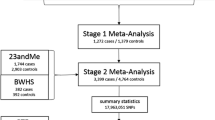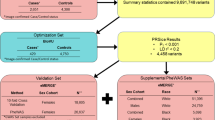Abstract
Uterine fibroids (UFs) affect 77 % of women by menopause and account for $9.4 billion in yearly healthcare costs. We recently replicated findings from the first UF genome-wide association study (GWAS), conducted in the Japanese. Here we tested these GWAS-discovered SNPs for association with UF characteristics to further assess whether risk varies by sub-phenotypes of UFs. Women were enrolled in Right from the Start (RFTS) and the BioVU DNA repository (BioVU). UF status was determined by pelvic imaging. We tested the top GWAS-associated SNPs for association with UF characteristics (RFTS: type, number, volume; BioVU: type) using covariate adjusted logistic and linear regression. We also combined association results of UF type using meta-analysis. 456 European American (EA) cases and 1,549 controls were examined. Trinucleotide repeat containing 6B (TNRC6B) rs12484776 associated with volume in RFTS (β = 0.40, 95 % CI 0.05–0.75, p = 0.024). RFTS analyses evaluating stratified quartiles of volume showed the strongest OR at rs12484776 for the largest volume (16.6–179.1 cc, odds ratio (OR) = 2.19, 95 % confidence interval (CI) 1.07–4.46, p = 0.031). Meta-analysis showed a strong association at blocked early in transport 1 homolog (BET1L) rs2280543 for intramural UFs (meta-OR = 0.51, standard error (SE) = 0.14, Q = 0.590, I = 0, p = 2.48 × 10−6), which is stronger than the overall association with UF risk. This study is the first to evaluate these SNPs for association with UF characteristics and suggests these genes associate with increasing UF volume and protection from intramural UF in EAs.
Similar content being viewed by others
References
Baird DD, Dunson DB (2003) Why is parity protective for uterine fibroids? Epidemiology 14:247–250
Baird DD, Dunson DB, Hill MC, Cousins D, Schectman JM (2003) High cumulative incidence of uterine leiomyoma in black and white women: ultrasound evidence. Am J Obstet Gynecol 188:100–107
Bonatz G, Frahm SO, Andreas S, Heidorn K, Jonat W, Parwaresch R (1998) Telomere shortening in uterine leiomyomas. Am J Obstet Gynecol 179:591–596
Cardozo ER, Clark AD, Banks NK, Henne MB, Stegmann BJ, Segars JH (2012) The estimated annual cost of uterine leiomyomata in the United States. Am J Obstet Gynecol 206:211–219
Cha PC, Takahashi A, Hosono N, Low SK, Kamatani N, Kubo M, Nakamura Y (2011) A genome-wide association study identifies three loci associated with susceptibility to uterine fibroids. Nat Genet 43:447–450
Cramer SF, Patel A (1990) The frequency of uterine leiomyomas. Am J Clin Pathol 94:435–438
Dragomir AD, Schroeder JC, Connolly A, Kupper LL, Hill MC, Olshan AF, Baird DD (2010) Potential risk factors associated with subtypes of uterine leiomyomata. Reprod Sci 17:1029–1035
Edwards, Michels K, artmann KE, Velez Edwards D (2013) Replication of fibroid GWAS associations in 10q24.33, 11p15.5, and 22q13.1 in a US population of reproductive aged women. Hum Genet (Epub ahead of print)
Eggert SL, Huyck KL, Somasundaram P, Kavalla R, Stewart EA, Lu AT, Painter JN, Montgomery GW, Medland SE, Nyholt DR, Treloar SA, Zondervan KT, Heath AC, Madden PA, Rose L, Buring JE, Ridker PM, Chasman DI, Martin NG, Cantor RM, Morton CC (2012) Genome-wide linkage and association analyses implicate FASN in predisposition to Uterine Leiomyomata. Am J Hum Genet 91:621–628
Eldar-Geva T, Meagher S, Healy DL, MacLachlan V, Breheny S, Wood C (1998) Effect of intramural, subserosal, and submucosal uterine fibroids on the outcome of assisted reproductive technology treatment. Fertil Steril 70:687–691
El-Gharib MN, Elsobky ES (2010) Cytogenetic aberrations and the development of uterine leiomyomata. J Obstet Gynaecol Res 36:101–107
Exacoustos C, Rosati P (1993) Ultrasound diagnosis of uterine myomas and complications in pregnancy. Obstet Gynecol 82:97–101
Faerstein E, Szklo M, Rosenshein NB (2001) Risk factors for uterine leiomyoma: a practice-based case-control study. II. Atherogenic risk factors and potential sources of uterine irritation. Am J Epidemiol 153:11–19
Flake GP, Andersen J, Dixon D (2003) Etiology and pathogenesis of uterine leiomyomas: a review. Environ Health Perspect 111:1037–1054
Guo Y, Shen H, Xiao P, Xiong DH, Yang TL, Guo YF, Long JR, Recker RR, Deng HW (2006) Genome wide linkage scan for quantitative trait loci underlying variation in age at menarche. J Clin Endocrinol Metab 91:1009–1014
Hartmann KE, Birnbaum H, Ben-Hamadi R, Wu EQ, Farrell MH, Spalding J, Stang P (2006) Annual costs associated with diagnosis of uterine leiomyomata. Obstet Gynecol 108:930–937
Kurbanova MK, Koroleva AG, Sergeev AS (1989) Genetic-epidemiologic analysis of uterine myoma: assessment of repeated risk. Genetika 25:1896–1898
Laughlin SK, Baird DD, Savitz DA, Herring AH, Hartmann KE (2009) Prevalence of uterine leiomyomas in the first trimester of pregnancy: an ultrasound-screening study. Obstet Gynecol 113:630–635
Laughlin SK, Herring AH, Savitz DA, Olshan AF, Fielding JR, Hartmann KE, Baird DD (2010a) Pregnancy-related fibroid reduction. Fertil Steril 94:2421–2423
Laughlin SK, Schroeder JC, Baird DD (2010b) New directions in the epidemiology of uterine fibroids. Semin Reprod Med 28:204–217
Laughlin SK, Hartmann KE, Baird DD (2011) Postpartum factors and natural fibroid regression. Am J Obstet Gynecol 204:496
Lumbiganon P, Rugpao S, Phandhu-fung S, Laopaiboon M, Vudhikamraksa N, Werawatakul Y (1996) Protective effect of depot-medroxyprogesterone acetate on surgically treated uterine leiomyomas: a multicentre case–control study. Br J Obstet Gynaecol 103:909–914
Luoto R, Kaprio J, Rutanen EM, Taipale P, Perola M, Koskenvuo M (2000) Heritability and risk factors of uterine fibroids—the Finnish Twin Cohort study. Maturitas 37:15–26
Malik M, Norian J, McCarthy-Keith D, Britten J, Catherino WH (2010) Why leiomyomas are called fibroids: the central role of extracellular matrix in symptomatic women. Semin Reprod Med 28:169–179
Marsh EE, Lin Z, Yin P, Milad M, Chakravarti D, Bulun SE (2008) Differential expression of microRNA species in human uterine leiomyoma versus normal myometrium. Fertil Steril 89:1771–1776
Marshall LM, Spiegelman D, Barbieri RL, Goldman MB, Manson JE, Colditz GA, Willett WC, Hunter DJ (1997) Variation in the incidence of uterine leiomyoma among premenopausal women by age and race. Obstet Gynecol 90:967–973
Marshall LM, Spiegelman D, Goldman MB, Manson JE, Colditz GA, Barbieri RL, Stampfer MJ, Hunter DJ (1998) A prospective study of reproductive factors and oral contraceptive use in relation to the risk of uterine leiomyomata. Fertil Steril 70:432–439
Moore AB, Flake GP, Swartz CD, Heartwell G, Cousins D, Haseman JK, Kissling GE, Sidawy MK, Dixon D (2008) Association of race, age and body mass index with gross pathology of uterine fibroids. J Reprod Med 53:90–96
Myers SL, Baird DD, Olshan AF, Herring AH, Schroeder JC, Nylander-French LA, Hartmann KE (2012) Self-report versus ultrasound measurement of uterine fibroid status. J Womens Health (Larchmt) 21:285–293
Ojeda VJ (1979) The pathology of hysterectomy specimens. N Z Med J 89:169–171
Parazzini F, Negri E, La VC, Chatenoud L, Ricci E, Guarnerio P (1996) Reproductive factors and risk of uterine fibroids. Epidemiology 7:440–442
Promislow JH, Makarushka CM, Gorman JR, Howards PP, Savitz DA, Hartmann KE (2004) Recruitment for a community-based study of early pregnancy: the right from the start study. Paediatr Perinat Epidemiol 18:143–152
Pulley J, Clayton E, Bernard GR, Roden DM, Masys DR (2010) Principles of human subjects protections applied in an opt-out, de-identified biobank. Clin Transl Sci 3:42–48
Purcell S, Neale B, Todd-Brown K, Thomas L, Ferreira MA, Bender D, Maller J, Sklar P, de Bakker PI, Daly MJ, Sham PC (2007) PLINK: a tool set for whole-genome association and population-based linkage analyses. Am J Hum Genet 81:559–575
Ramzy AM, Sattar M, Amin Y, Mansour RT, Serour GI, Aboulghar MA (1998) Uterine myomata and outcome of assisted reproduction. Hum Reprod 13:198–202
Rosati P, Bellati U, Exacoustos C, Angelozzi P, Mancuso S (1989) Uterine myoma in pregnancy: ultrasound study. Int J Gynaecol Obstet 28:109–117
Samadi AR, Lee NC, Flanders WD, Boring JR III, Parris EB (1996) Risk factors for self-reported uterine fibroids: a case–control study. Am J Public Health 86:858–862
Snieder H, MacGregor AJ, Spector TD (1998) Genes control the cessation of a woman’s reproductive life: a twin study of hysterectomy and age at menopause. J Clin Endocrinol Metab 83:1875–1880
Sozen I, Arici A (2002) Interactions of cytokines, growth factors, and the extracellular matrix in the cellular biology of uterine leiomyomata. Fertil Steril 78:1–12
Takeda T, Sakata M, Isobe A, Miyake A, Nishimoto F, Ota Y, Kamiura S, Kimura T (2008) Relationship between metabolic syndrome and uterine leiomyomas: a case-control study. Gynecol Obstet Invest 66:14–17
Treloar SA, Martin NG, Dennerstein L, Raphael B, Heath AC (1992) Pathways to hysterectomy: insights from longitudinal twin research. Am J Obstet Gynecol 167:82–88
Vollenhoven B (1998) Introduction: the epidemiology of uterine leiomyomas. Baillieres Clin Obstet Gynaecol 12:169–176
Willer CJ, Li Y, Abecasis GR (2010) METAL: fast and efficient meta-analysis of genome wide association scans. Bioinformatics 26:2190–2191
Wise LA, Palmer JR, Harlow BL, Spiegelman D, Stewart EA, Adams-Campbell LL, Rosenberg L (2004) Reproductive factors, hormonal contraception, and risk of uterine leiomyomata in African–American women: a prospective study. Am J Epidemiol 159:113–123
Wise LA, Ruiz-Narvaez EA, Palmer JR, Cozier YC, Tandon A, Patterson N, Radin RG, Rosenberg L, Reich D (2012) African ancestry and genetic risk for uterine leiomyomata. Am J Epidemiol 176:1159–1168
Acknowledgments
The field research for Right from the Start was supported by grants from the National Institute of Child and Human Development (R01HD043883 and R01HD049675) and the American Water Works Association Research Foundation (2579). Additional funds were provided by the Building Interdisciplinary Research Careers in Women’s Health career development program (2K12HD043483-11) to DRVE, the Vanderbilt Clinical and Translational Research Scholar Award 5KL2RR024977 to TLE from the National Center for Advancing Translational Sciences, the Vanderbilt CTSA award UL1TR000445 from the National Center for Advancing Translational Sciences, and the BioVU dataset used for the analyses described was obtained from Vanderbilt University Medical Center’s BioVU which is supported by institutional funding and by the Vanderbilt CTSA Grant ULTR000445 from NCATS/NIH. The contents of this manuscript are solely the responsibility of the authors and do not necessarily represent official views of the National Center for Advancing Translational Sciences or the National Institutes of Health. No co-authors have any conflicts of interest to disclose and the material submitted for publication has not been previously reported and is not under consideration for publication elsewhere.
Author information
Authors and Affiliations
Corresponding author
Electronic supplementary material
Below is the link to the electronic supplementary material.
Rights and permissions
About this article
Cite this article
Edwards, T.L., Hartmann, K.E. & Velez Edwards, D.R. Variants in BET1L and TNRC6B associate with increasing fibroid volume and fibroid type among European Americans. Hum Genet 132, 1361–1369 (2013). https://doi.org/10.1007/s00439-013-1340-1
Received:
Accepted:
Published:
Issue Date:
DOI: https://doi.org/10.1007/s00439-013-1340-1




